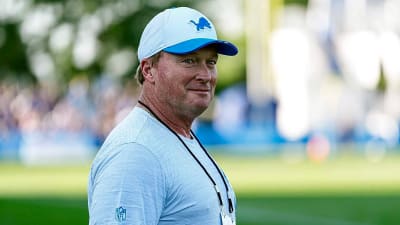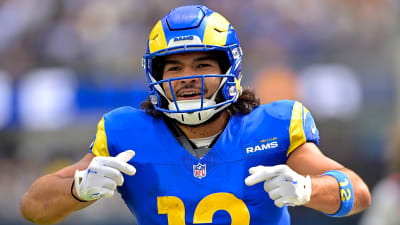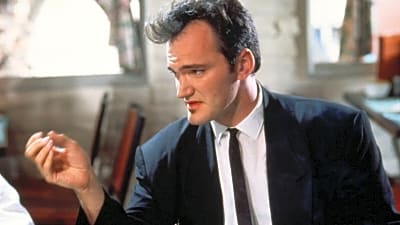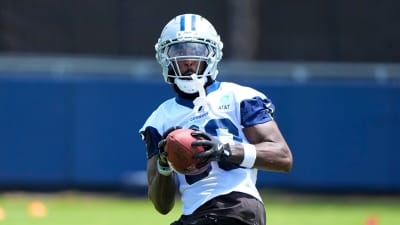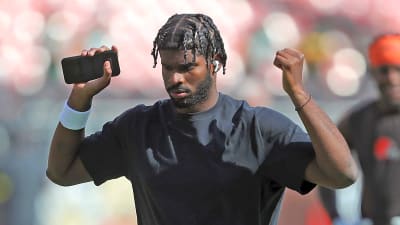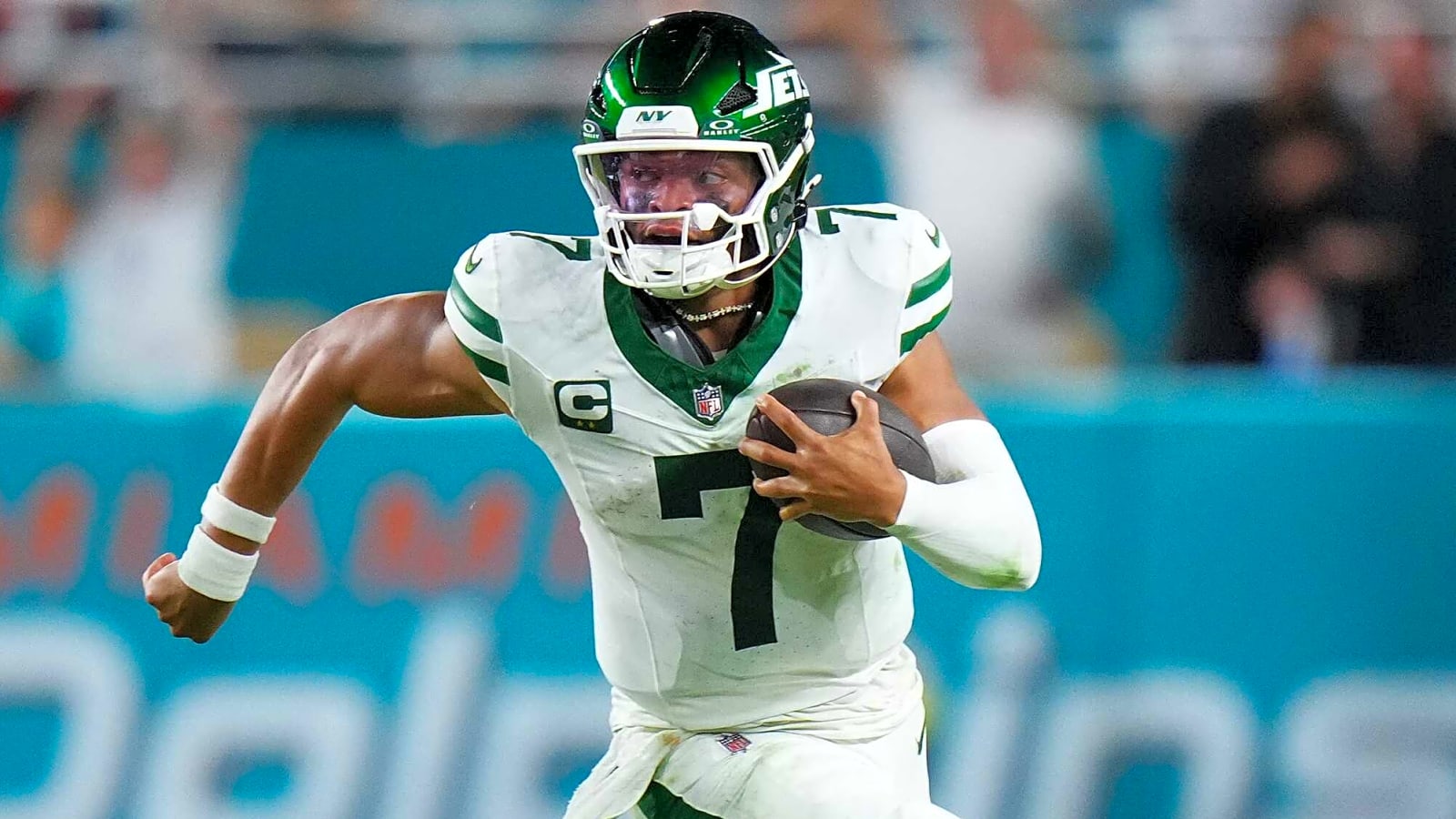
We’re nearly one quarter of the way through the 2025 NFL season, which means it’s a great time to check in on the status of the New York Jets’ roster.
Which positions are most to blame for the 0-4 start? Which positions are developing into building blocks for the future?
Let’s answer those questions by analyzing every Jets position group and stacking it up against the rest of the NFL. We’ll combine various metrics to estimate where the Jets rank league-wide at each position.
Offensive line
Key Rankings:
- PFF overall grade: 65.5 (8th)
- ESPN pass block win rate: 60% (18th)
- ESPN run block win rate: 74% (8th)
- Average rank: 11.3
The Jets’ offensive line is off to a solid start. It hasn’t quite fulfilled the elite potential many believed it had, but most metrics suggest it has been above-average, especially in the run game.
When accumulating the individual grades of the Jets’ offensive linemen, the unit has performed at a top-10 level. That is primarily thanks to Armand Membou, who has been a phenom. If the Jets want to take another leap toward the elite ranks, they need Olu Fashanu to brush off a sluggish start to his second season.
Wide receivers
Key Rankings:
- PFF overall grade: 61.6 (27th)
- Yards per route run: 1.10 (27th)
- Drop rate: 7.1% (22nd)
- Snaps per penalty: 107.7 (31st)
- PFF run-blocking grade: 54.2 (10th)
- Average rank: 23.4
As expected, the Jets’ wide receiver unit is a liability. Despite Garrett Wilson getting off to one of his strongest starts, the Jets simply don’t have enough outside of him to lift this group out of the NFL’s cellar.
On the positive side of things, the unit has blocked relatively well for the position.
Tight ends
Key Rankings:
- PFF overall grade: 57.5 (22nd)
- Yards per route run: 1.10 (19th)
- Drop rate: 6.3% (19th)
- Snaps per penalty: 97.3 (26th)
- Pressure rate allowed in pass protection: 20.8% (32nd)
- PFF run-blocking grade: 52.5 (27th)
- Average rank: 24.2
It has been a rough start for the Jets’ tight ends, particularly in the blocking game, where they have allowed pressure at the highest rate and also struggled to open up holes in the run game.
Mason Taylor leads NFL tight ends with four pressures allowed. Meanwhile, Jeremy Ruckert has graded poorly as a run blocker (48.0 grade). The duo has also combined for three penalties (two of those on Taylor).
In the passing game, the tight ends have seldom been involved, but they have typically executed their rare opportunities.
Running backs
Key Rankings:
- PFF overall grade: 63.5 (21st)
- Yards per rush attempt: 4.55 (11th)
- Yards after contact per rush attempt: 3.09 (15th)
- Missed tackles forced per rush attempt: 0.09 (29th)
- Rushing yards over expected per attempt: 0.19 (17th)
- Touches per fumble: 93.0 (20th)
- Yards per route run: 1.46 (8th)
- Drop rate: 14.3% (30th)
- Pressure rate allowed in pass protection: 10.0% (14th)
- Average rank: 18.3
The Jets’ running back unit has generally been mediocre – not bad, not good.
Braelon Allen has been the unit’s worst performer in most categories, and he is about to miss extended time, so we shall see if Isaiah Davis proves to be an upgrade in Allen’s role.
Quarterbacks
Key Rankings:
- PFF overall grade: 67.6 (19th)
- QBR: 55.9 (19th)
- EPA per dropback (per RBSDM): 0.078 (19th)
- Passer rating: 98.0 (11th)
- Passing DVOA: 11.0% (21st)
- Net yards per attempt: 5.4 (25th)
- Average rank: 19.0
These rankings are probably much higher than many fans expected. As it turns out, the numbers are surprisingly fond of New York’s quarterback play relative to public perception.
From a statistical standpoint, the Jets’ quarterback room has two major things working in its favor: a lack of interceptions and elite rushing production. These are the factors making the quarterback room look more respectable than you’d expect based on its obvious weaknesses.
New York is tied for the fewest interceptions with one, which is certainly helping Justin Fields and Tyrod Taylor look good in multiple metrics, particularly passer rating, which heavily values interceptions.
Additionally, Fields leads quarterbacks in rushing first downs per game (3.4) and is second in rushing yards per game (43.8). He has been particularly explosive on scrambles, and since most advanced metrics count scrambles as part of pass-game production, Fields’ mobility is doing plenty of heavy lifting in his overall efficiency metrics. Taylor has also run the ball fairly well during his time on the field.
You also have to give props to offensive coordinator Tanner Engstrand for dialing up concepts that have allowed the Jets’ pass game to stay on schedule. While Fields and Taylor have each dealt with accuracy issues at times, Engstrand’s scheme has created enough easy completions for the Jets’ quarterbacks to complete 67.3% of their passes, which ranks 13th in the league.
The primary downside of the Jets’ quarterback room is its lack of explosiveness, as evidenced by New York’s 25th-ranked placement in net yards per attempt. While the quarterbacks have been solid at avoiding interceptions, completing an above-average percentage of passes, and using their legs, they are flat-out unable to generate big plays through the air, which places a firm cap on their ceiling.
Overall, the Jets are getting a level of quarterback play that is respectable enough to win some games if the surrounding pieces excel. Fields and Taylor aren’t nearly good enough to carry the team to wins if the supporting cast is mediocre or worse, but if the supporting cast fires on all cylinders, they shouldn’t prevent the team from winning games they deserve to win.
So far, though, the Jets have gotten poor results from their wide receivers, tight ends, returners, and most of the defense, while the running backs have been average at best. Without elite quarterback play to save the day, that formula will lead to plenty of losses.
But if the rest of the Jets’ roster can somehow figure things out, New York is getting respectable enough game management from the quarterback position to squeak out some wins.
Edge rushers
Key Rankings:
- PFF overall grade: 51.7 (31st)
- Pressure rate: 8.3% (29th)
- Run stop rate: 5.0% (23rd)
- Missed tackle rate: 25% (31st)
- Snaps per penalty: 264.5 (12th)
- Average rank: 25.2
The Jets’ edge unit has been nothing short of abysmal. They cannot generate pressure or stop the run, and they miss way too many tackles.
With Jermaine Johnson sidelined for most of the season so far, Will McDonald has been this unit’s only saving grace. Past McDonald, the Jets are left with a group of guys who wouldn’t even stand out in the fourth quarter of the third preseason game.
Defensive tackles
Key Rankings:
- PFF overall grade: 72.3 (2nd)
- Pressure rate: 10.7% (18th)
- Run stop rate: 11.2% (1st)
- Missed tackle rate: 33.3% (27th)
- Snaps per penalty: 257.5 (21st)
- Average rank: 13.8
A rare bright spot for the Jets’ defense, New York’s defensive tackle unit is off to a solid start, particularly in the run game.
Quinnen Williams has been dominant against the run. Couple him with a pair of quality run stuffers in Harrison Phillips and Jowon Briggs, and the Jets have perhaps the best group of interior run stuffers in the NFL.
While the unit hasn’t necessarily been poor in the pass game, its consistency at generating pressure has only been about average. That’s because Williams is on his own in this phase. He has a 12.1% pressure rate and is tied for eighth at the position with 13 total pressures, but all other Jets defensive tackles have combined for 10 pressures on a 6% pressure rate.
On the downside, this group is not exempt from the tackling struggles that have plagued the entire Jets defense.
Linebackers
Key Rankings:
- PFF overall grade: 61.8 (17th)
- Run stop rate: 5.7% (24th)
- Yards allowed per coverage snap: 0.94 (18th)
- Yards allowed per target: 8.0 (20th)
- TD/INT margin in coverage: 2 to 0; +2 (20th)
- Missed tackle rate: 11.4% (15th)
- Pressure rate: 16.7% (16th)
- Snaps per penalty: 292.0 (25th)
- Average rank: 19.4
There are many linebacker units struggling more than the Jets’, but the unit has unquestionably performed at a below-average level, which is highly disappointing relative to the expectations of New York’s unit.
Quincy Williams had a brutal 23.5% missed tackle rate before he was sidelined due to injury. Jamien Sherwood has not been as poor in the missed tackle department, and he has actually been quite good against the run, but his coverage has been woeful. Opponents are averaging 9.7 yards per target when throwing into Sherwood’s coverage.
Cornerbacks
Key Rankings:
- PFF overall grade: 58.6 (22nd)
- Yards allowed per coverage snap: 0.94 (14th)
- Yards allowed per target: 7.1 (16th)
- TD/INT margin in coverage: 4 to 0; +4 (24th)
- Missed tackle rate: 11.3% (7th)
- Run stop rate: 4.2% (1st)
- Snaps per penalty: 107.7 (16th)
- Average rank: 14.3
As much as it has seemed like the Jets’ cornerback unit is struggling, it checks in as an average-ish unit from a statistical standpoint. Many groups around the league have ceded significantly more yards, committed penalties far more frequently, and missed tackles at a higher rate.
New York’s ratio of four touchdowns to no interceptions is problematic, but in terms of yardage, missed tackles, and penalties, the Jets’ cornerbacks have been average to above-average. They have also been excellent when it comes to run support.
It goes to show that fans often expect too much from NFL cornerbacks. Even the best cornerback play in the NFL is hardly pretty. If you think your team’s corners are struggling, you might want to look around the NFL and see how the rest of the league is doing.
Sauce Gardner is the primary reason for the Jets’ respectable numbers at cornerback. Despite the excessive scrutiny he receives, Gardner is still having a solid season in coverage. He has allowed 0.85 yards per cover snap and 7.1 yards per target this season.
Those numbers are well below Gardner’s lofty personal standards, and the Jets should expect much more from him at his pay grade, but he has been far from “bad,” and they’ve needed his solid numbers with the struggles of Michael Carter II and Brandon Stephens (to Stephens’ credit, he has improved over the last two games).
Recent trade acquisition Jarvis Brownlee is set to replace Carter II in the slot this week. The second-year man should only further strengthen the Jets’ run support and tackling at cornerback, but he must show progress when it comes to penalties and preventing large chunks of yardage through the air.
Safeties
Key Rankings:
- PFF overall grade: 56.6 (26th)
- Yards allowed per coverage snap: 0.78 (30th)
- Yards allowed per target: 10.7 (29th)
- TD/INT margin in coverage: 1 to 0; +1 (18th)
- Missed tackle rate: 20.0% (29th)
- Run stop rate: 2.6% (16th)
- Snaps per penalty: 290.5 (22nd)
- Average rank: 24.3
While the cornerbacks and linebackers have been shaky, the safeties have been the most persistent issue in the Jets’ back-seven.
New York’s safeties have yielded massive bundles of yardage in coverage while missing a boatload of tackles. Andre Cisco is the primary culprit, leading the Jets’ safeties in both missed tackles (5) and yards allowed (117).
Tony Adams isn’t off the hook. Despite playing 120 fewer snaps than Cisco, Adams has still missed four tackles and allowed 60 yards on just six targets.
The Jets’ backups have not inspired much hope. Rookie Malachi Moore has missed a pair of tackles while allowing 22 yards on three targets, and he is lucky to have not allowed significantly more yards based on a drop and multiple blown coverages where he was not targeted. Isaiah Oliver missed three tackles and allowed 36 yards on just 56 snaps (26 in coverage).
Kicker
Key Rankings:
- Field goal percentage: 100% (T-1st)
- Extra point percentage: 100% (T-1st)
- Kickoff touchback rate: 6.7% (6th)
- Average rank: 2.7
What can you say? Nick Folk has been an ageless wonder. He’s made all seven of his field goal attempts with four of them coming from 50+ yards, along with all seven of his extra point attempts.
Folk has also mastered the revamped kickoff, consistently dropping the ball just shy of the goal line to help maximize New York’s field position.
Punter
Key Rankings:
- PFF overall grade: 83.2 (2nd)
- Net yards per punt: 44.2 (4th)
- Punt DVOA: +3.6 (8th)
- Average punt hang time: 4.76 (2nd)
- Average rank: 4.0
Every metric agrees that second-year punter Austin McNamara has been lighting it up in his first four NFL games, continuing the promise he showed in the preseason. Credit is also due to New York’s coverage team, which has backed McNamara up with excellent tackling.
The Jets have a case for the league’s best kicker-punter duo thus far.
Position rankings
Here are the average rankings we arrived upon for each position.
- K (2.7)
- P (4.0)
- OL (11.3)
- DT (13.8)
- CB (14.3)
- RB (18.3)
- QB (19.0)
- LB (19.4)
- WR (23.4)
- TE (24.2)
- S (24.3)
- EDGE (25.2)
If the Jets want to turn their season around, they will need substantial improvement from four position groups (two on each side of the ball): wide receiver, tight end, safety, and edge rusher.
Going forward, those four positions are shaping up to be the team’s most pressing non-quarterback needs when the 2026 offseason arrives.
More must-reads:
- Veteran wideout announces retirement from NFL
- Jerry Jones addresses Taylor Swift possibly attending Chiefs-Cowboys game
- The 'Active multiple 140-receiving-yard games' quiz
Breaking News
Trending News
Customize Your Newsletter
 +
+
Get the latest news and rumors, customized to your favorite sports and teams. Emailed daily. Always free!


